
Introduction
There's been a steady growth of Ultra HD and 4k
resolutions over the last year or so in the monitor market. Initial screens were
in a large format, but super high resolutions have started to enter smaller
screen sizes as well. It's important before we start, to understand that this
increase in resolution needs to be thought of differently to monitors of the
past. It's not really about providing more screen real estate and working space
unless the size of the screen is also increased significantly as well. It's
about providing sharper scaled images on the screen, with a similar overall
desktop real estate to work with. Rather than us go in to it in a lot of detail
here, we would really recommend a read of
Eizo's very useful article about this subject. That will hopefully make the
whole thing much clearer.
We have with us at the moment a 27" sized screen
from ViewSonic, their new flagship model in their Professional VP series. The
VP2780-4K is designed for CAD/Cam, photography, architecture and video editing
according to their website and its highlights are an Ultra HD 3840 x 2160
resolution, IPS panel and 10-bit colour depth. It also carries a few advanced
features including factory calibration, a 14-bit 3D LUT and MultiPicture (PiP
and PbP) functionality. Note that although this is a professional range monitor
it sticks to a normal sRGB gamut which is more commonly needed than wide gamut
and avoids unnecessary additional cost. In fact if you look back at the previous
27" VP models you will see the
VP2710-LED in 2012 had a standard gamut and 1440p resolution, the
VP2772 in 2014 moved to wide gamut at 1440p, and now the VP2780-4K reverts
to standard gamut again but this time with Ultra HD resolution.
If you appreciate the review
and enjoy reading and like our work, we would welcome a
donation
to the site to help us continue to make quality and detailed reviews for you.

Specifications and Features
The following table gives detailed information
about the specs of the screen:
|
Monitor
Specifications |
|
Size |
27"WS (68.47 cm) |
Panel Coating |
Light AG coating |
|
Aspect Ratio |
16:9 |
Interfaces |
1x DisplayPort 1.2a
1x Mini DisplayPort 1.2a
1x HDMI 2.0
2x HDMI 1.4 / MHL 2.0
|
|
Resolution |
3840 x 2160 |
|
Pixel Pitch |
0.156 mm |
Design
colour |
All matte black design |
|
Response Time |
5ms G2G |
Ergonomics |
Tilt, 150mm height, swivel and rotate |
|
Static Contrast Ratio |
1000:1 |
|
Dynamic Contrast Ratio |
20 million:1 |
VESA Compatible |
Yes, 100 x 100 |
|
Brightness |
350 cd/m2 |
Accessories |
Power cable and brick, DisplayPort, HDMI, MHL
and USB cables. Factory calibration report |
|
Viewing Angles |
178 / 178 |
|
Panel Technology |
LG.Display AH-IPS |
Weight |
8.36Kg (with stand) |
|
Backlight Technology |
W-LED |
Physical Dimensions |
(WxHxD) with stand:
642.7 x 469.7x 347.8 mm |
|
Colour Depth |
1.07b (8-bit + AFRC) |
|
Refresh Rate |
60Hz |
Special
Features |
4x
USB 3.0 ports (charging supported), factory calibration, PiP and PbP
support, headphone jack |
|
Colour Gamut |
Standard gamut
100% sRGB, 80% Adobe RGB, 99% EBU, 75% NTSC |
The VP2780-4K offers a decent range of connectivity
options with DisplayPort, Mini DisplayPort, HDMI 2.0 and 2x HDMI 1.4 / MHL 2.0
provided. The digital interfaces are HDCP certified for encrypted content and
the video cables are provided in the box for HDMI, MHL and DP. The DisplayPort
and HDMI 2.0 connections can support the full 3840 x 2160 resolution at 60Hz
refresh rate, with the other HDMI inputs only supporting that resolution at 30Hz
maximum.
The screen has an external power supply brick
which is provided of course. There is a headphone output connection
although no integrated speakers on this model. There are also 4x USB 3.0 ports on this model,
but no other extras like ambient
light sensors or motion sensors.
Below is a summary of the features and connections
of the screen:
|
Feature |
Yes / No |
Feature |
Yes / No |
|
Tilt adjust |
 |
DVI |
 |
|
Height adjust |
 |
HDMI |
 |
|
Swivel adjust |
 |
D-sub |
 |
|
Rotate adjust |
 |
DisplayPort |
 |
|
VESA compliant |
 |
Component |
 |
|
USB 2.0 Ports |
 |
Composite |
 |
|
USB 3.0 Ports |
 |
Audio connection |
 |
|
Card Reader |
 |
HDCP Support |
 |
|
Ambient Light Sensor |
 |
MHL Support |
 |
|
Human Motion Sensor |
 |
Integrated Speakers |
 |
|
Touch Screen |
 |
PiP / PbP |
 |
|
Factory Calibration |
 |
Blur Reduction Mode |
 |
|
Hardware calibration |
 |
G-Sync |
 |
|
Uniformity correction |
 |
FreeSync |
 |

Design and Ergonomics



Above: front
views of the screen. Click for larger versions
The VP2780-4K comes in an all black design,
with matte black plastics used for the bezel, stand and base. The bezel
measures ~21mm around all edges and looks quite thin as a result. There is
a subtle grey ViewSonic logo in the middle of the bottom bezel, and grey
OSD control labels in the bottom right hand corner. Other than that there
are no further writings or logos on the front of the screen.

Above: rear
view of the screen. Click for larger version
The back of the screen is again a matte
black plastic. The stand connects in the middle at the back and can be
unscrewed if you want for VESA 100 compliant mounting options. There are
some cable tidy clips on the back of the stand as well as you can see
above.

Above: side
profile view. Click for larger version
From the side you can see the actual panel
has a thin profile, thanks to the use of W-LED backlighting and an
external power supply. The stand however creates a much deeper footprint.
It is 347.8mm (nearly 35cm) deep so you do need a fairly deep desk to
accommodate the screen, without it being very close to you. With the stand
being very wide and deep it does provide a very sturdy base for the screen
though and from the front does not look overly chunky.
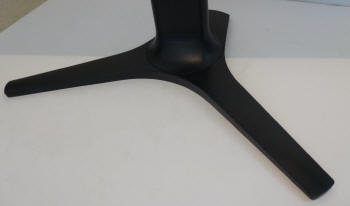
Above: view
of the base. Click for larger version
The base of the stand is shown above. We did
feel the stand gives the screen a slightly industrial and sturdy feel, as
opposed to being focused on sleek design. ViewSonic have kept this stand
design for this range for a long time though and it is a case of function
over design perhaps. Not a criticism really, more an observation.


Above: full
tilt range. Click for larger versions
The screen offers a full range of ergonomic
adjustments. The tilt adjustment is smooth and easy to move and offers a
nice wide range as well as shown above.
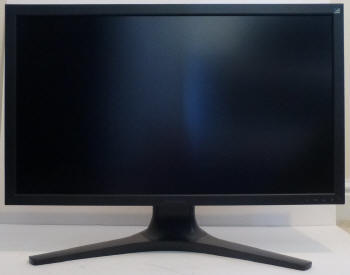
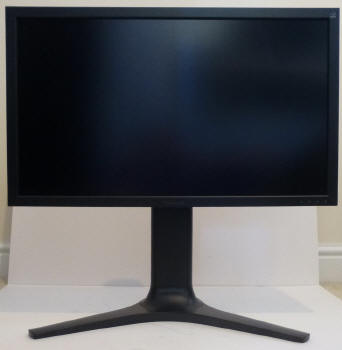
Above: full
height adjustment range. Click for larger versions
Height adjustment is smooth but a little
stiff to operate, but again provides a very good range. At the lowest
setting the bottom edge of the screen is 8cm from the edge of the desk,
and at the highest setting it is 23cm. This gives you a total 15cm (150mm)
adjustment range as advertised.

Above:
rotated view. Click for larger version
The side to side swivel and rotation
function are both smooth but quite stiff to operate. Nice to see a full
range of adjustments offered from the stand here.
A summary of the screens ergonomic adjustments
is shown below:
|
Function |
Range |
Smoothness |
Ease of Use |
|
Tilt |
Yes |
Smooth |
Easy |
|
Height |
150mm |
Smooth |
Quite Stiff |
|
Swivel |
Yes |
Smooth |
Quite Stiff |
|
Rotate |
Yes |
Smooth |
Quite Stiff |
|
Overall |
Good range of adjustments and
easy enough to move. Sturdy stand and base. |
The materials were of good standard and the
design and build quality felt robust and sturdy. There was no audible noise from the screen,
even when conducting specific tests which can often identify buzzing issues.
The whole screen remained reasonably cool during prolonged use.

Above:
interface connections on the back of the screen. Click for larger version
The back of the screen features all the
connections along the underside of the central section. There is, from left to
right, USB upstream, 2x USB 3.0 downstream, MHL 2, MHL 1, HDMI 2.0,
DisplayPort, Mini DisplayPort, headphone port and the power connection.

OSD Menu
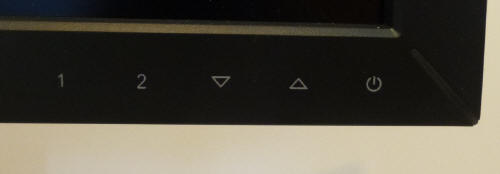
Above: OSD control buttons
on the bottom edge of the screen. Click for larger version
The OSD menu is accessed and controlled through a
series of 5 touch-sensitive buttons located on the front of the screen in the
bottom right hand corner (including the power on/off button).
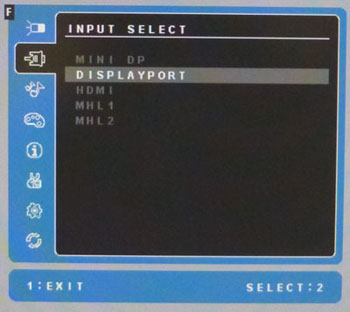
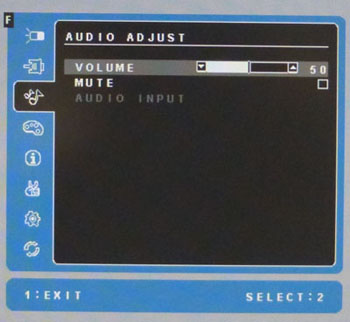
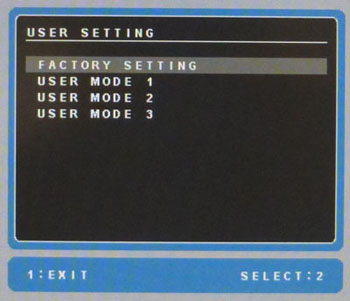
There is quick access to the input selection,
volume control and saveable user modes via the 2, down arrow and up arrow buttons.
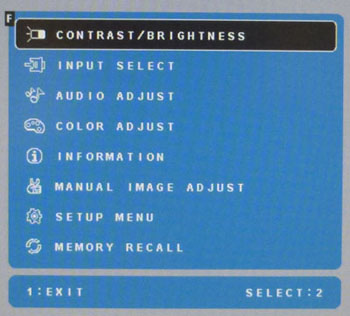
Pressing the 1 button brings up the main OSD menu
as shown above. This is split in to 8 sections.
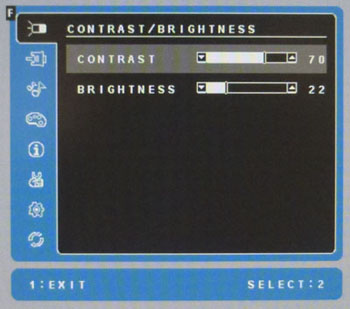
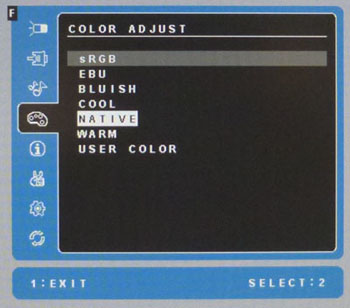
The first section gives you access to the
brightness and contrast controls. We've already looked at the second and third
sections which are also available via the quick launch controls (input selection
and audio control). Therefore the second photo above is of the fourth section,
the 'color adjust' menu. Here you can switch between a series of preset colour
temperature modes.
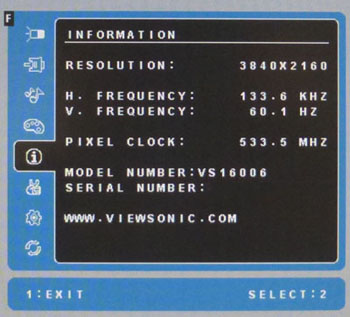
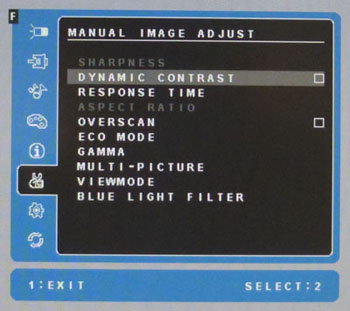
The fifth section gives you information about the
screen and there aren't any settings to change here. The sixth section however
is the 'manual image adjust' menu and has lots of things to play with. There is
the dynamic contrast ratio option if you wanted to use that. There's also
control over the response time setting which
we will test
later on in the review.
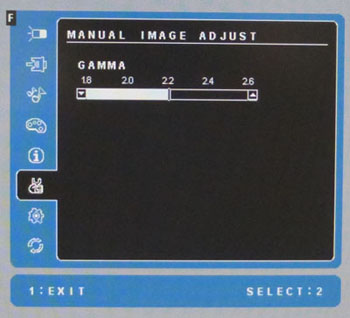
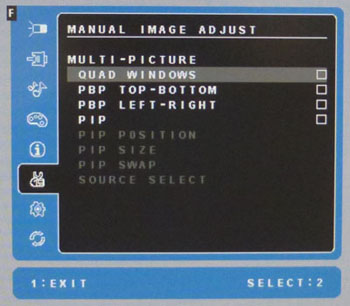
The gamma control in this section allows you to
adjust the gamma level if you need to. There is also a selection of settings for
the PiP / PbP option in the 'multi picture' option.
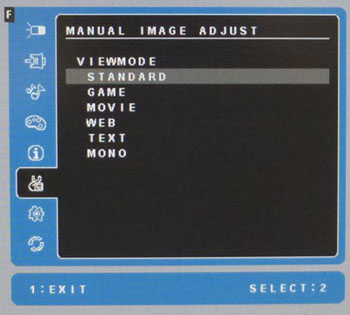
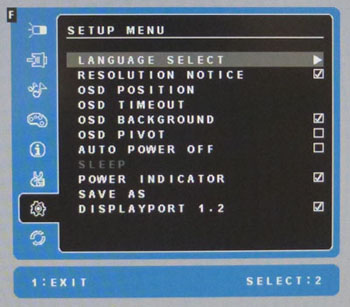
Elsewhere in the same 'manual image adjust'
section of the menu you can switch between the 'view modes' as shown. The
seventh section of the menu (right hand image) allows you to control various
things related mainly to the OSD itself. The last section of the main menu is
the 'memory recall' option for resetting the screen.
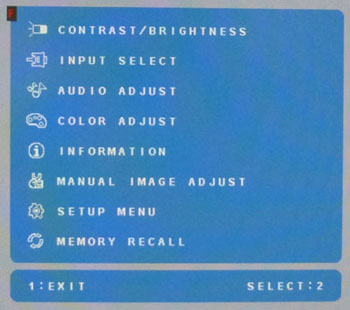
There is also a hidden factory menu on the screen
if you hold the 1 button while powering on the screen. Pressing 1 to then bring
up the main menu you will see a small "F" at the top. If you scroll up to this
and enter, there is another menu as shown below.
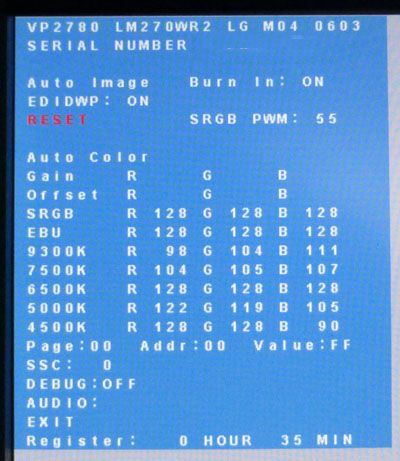

Power Consumption
We carried out our normal tests to establish its
power consumption of the display, as compared with the specified values from the
manufacturer:
|
 |
|
State and Brightness
Setting |
Manufacturer Spec (W) |
Measured Power Usage
(W) |
|
Default (100%) |
46.5 |
42.9 |
|
Calibrated (8%) |
- |
20.5 |
|
Maximum Brightness (100%) |
- |
42.9 |
|
Minimum Brightness (0%) |
- |
19.2 |
|
Standby |
- |
0.5 |
|
We tested this ourselves and found that out of the
box the screen used 42.9W at the default 100% brightness setting. Once
calibrated to a far more comfortable brightness level the power consumption was
only 20.5W. In standby it
used only 0.5W. We have plotted these results below compared with other screens
we have tested. You will notice the calibrated power consumption is very similar
to other W-LED backlit displays. Wide gamut LED backlights (e.g. ViewSonic
VP2772) use a bit more, and CCFL units (e.g. Eizo SX2762W and NEC PA271W) use
quite a considerable amount more.


Panel and Backlighting
|
Panel Manufacturer |
LG.Display |
Colour Palette |
1.07 billion |
|
Panel Technology |
AH-IPS |
Colour Depth |
8-bit + AFRC |
|
Panel Module |
LM270WR2 |
Colour space |
Standard gamut |
|
Backlighting Type |
W-LED |
Colour space coverage (%) |
75% NTSC, 80% Adobe RGB, 100% sRGB, 99% EBU |
Panel Part and Colour Depth
The screen features an
LG.Display LM270WR2 AH-IPS panel which is capable of producing 1.07 billion
colours. The panel offers an 8-bit colour depth with an additional Advanced
Frame Rate Control (8-bit + AFRC) stage added at a panel level. Keep in mind
whether this is practically useable and whether you're ever going to truly
use that colour depth. You need to have a full 10-bit end to end workflow to
take advantage of it which is still quite expensive to achieve and rare in the
market, certainly for your average user. This includes relevant applications and
graphics cards as well, so to many people this 10-bit support might be
irrelevant. The part is confirmed when accessing the factory OSD menu as shown
below:

Screen
Coating
The
screen coating is a light anti-glare (AG) offering. It isn't a semi-glossy
coating, but it is light as seen on other modern IPS type panels. Thankfully it
isn't a heavily grainy coating like some old IPS panels feature. It retains its
anti-glare properties to avoid too many unwanted reflections of a full glossy
coating, but does not produce an too grainy or dirty an image that some thicker
AG coatings can. There were no cross-hatching patterns visible on the
coating even when you inspect it closely.
Backlight Type and Colour Gamut
The screen uses a White-LED (W-LED) backlight unit
which has become the norm in today's market. This helps reduce power
consumption compared with older generation CCFL backlight units and brings about some
environmental benefits as well. The W-LED unit offers a standard colour gamut
which is approximately equal to the sRGB colour space.
Studying the detailed spec provided by ViewSonic states that there is a colour space coverage of
75%
NTSC, 80% Adobe RGB, 99% EBU and 100% sRGB. Anyone wanting to work with wider colour spaces would need to consider wide
gamut CCFL screens or the newer range of GB-r-LED type displays available
now. If
you want to read more about colour spaces and gamut then please have a read of
our
detailed article.
Backlight
Dimming and Flicker
We tested the screen to establish the methods used
to control backlight dimming. Our in depth article talks in more details about a
common method used for this which is called
Pulse Width Modulation (PWM). This in itself gives cause for concern to some
users who have experienced eye strain, headaches and other symptoms as a result
of the flickering backlight caused by this technology. We use a photosensor +
oscilloscope system to measure backlight dimming control
with a high level of accuracy and ease. These tests allow us to establish
1) Whether PWM is being used to control the
backlight
2) The frequency and other characteristics at which this operates, if it is used
3) Whether a flicker may be introduced or potentially noticeable at certain
settings
If PWM is used for backlight dimming, the higher
the frequency, the less likely you are to see artefacts and flicker. The duty
cycle (the time for which the backlight is on) is also important and the shorter
the duty cycle, the more potential there is that you may see flicker. The other
factor which can influence flicker is the amplitude of the PWM, measuring the
difference in brightness output between the 'on' and 'off' states. Please
remember that not every user would notice a flicker from a backlight using PWM,
but it is something to be wary of. It is also a hard thing to quantify as it is
very subjective when talking about whether a user may or may not experience the
side effects.
100% 50%
0%



Above scale = 1
horizontal grid = 5ms
At all brightness settings a direct current (DC)
method is used for backlight dimming, instead of any PWM method. As a result,
the screen is flicker free as advertised.
|
Pulse Width
Modulation Used |
No |
|
Cycling
Frequency |
n/a |
|
Possible
Flicker at |
|
|
100% Brightness |
No |
|
50% Brightness |
No |
|
0% Brightness |
No |
For an up to date list of all flicker-free (PWM free) monitors please see our
Flicker Free Monitor Database.

Contrast
Stability and Brightness
We wanted to see how much variance there was in
the screens contrast as we adjusted the monitor setting for brightness.
In theory, brightness and contrast are two independent parameters, and good
contrast is a requirement regardless of the brightness adjustment.
Unfortunately, such is not always the case in practice. We recorded the
screens luminance and black depth at various OSD brightness settings, and
calculated the contrast ratio from there. Graphics card settings were left at
default with no ICC profile or calibration active. Tests were made using an
X-rite i1 Display Pro colorimeter. It should be noted that we used the
BasICColor calibration software here to record these, and so luminance at
default settings may vary a little from the LaCie Blue Eye Pro report.
|
OSD
Brightness |
Luminance
(cd/m2) |
Black
Point (cd/m2) |
Contrast
Ratio
( x:1) |
|
100 |
411.33 |
0.38 |
1082 |
|
90 |
375.96 |
0.35 |
1074 |
|
80 |
345.88 |
0.32 |
1081 |
|
70 |
315.60 |
0.29 |
1088 |
|
60 |
284.96 |
0.27 |
1055 |
|
50 |
253.96 |
0.24 |
1058 |
|
40 |
222.50 |
0.21 |
1060 |
|
30 |
190.68 |
0.18 |
1059 |
|
20 |
158.36 |
0.15 |
1056 |
|
10 |
125.71 |
0.12 |
1048 |
|
0 |
92.68 |
0.09 |
1030 |
|
Total Luminance Adjustment Range
(cd/m2) |
318.65 |
Brightness OSD setting controls backlight? |
 |
|
Total Black Point
Adjustment Range (cd/m2) |
0.29 |
|
Average Static Contrast Ratio |
1063:1 |
PWM Free? |
 |
|
Recommended OSD setting
for 120 cd/m2 |
8 |
The brightness control gave us a very good range
of adjustment. At the top end the maximum luminance reached 411
cd/m2 which was
extremely high, and quite a bit more even than the specified maximum brightness
(370 cd/m2) from the manufacturer. There was a decent 319 cd/m2 adjustment
range in total, and so at the minimum setting you could reach down to a fairly
low luminance of 93 cd/m2. This should be adequate for most
people wanting to work in darkened room conditions with lower ambient light,
although it could have done with being a little lower we felt. We'd gladly have
sacrificed some range at the higher end. A setting of only 8 in the OSD menu
should return you a luminance of around 120 cd/m2 at default settings.
It should be noted that the
brightness regulation is controlled without the need for
Pulse Width Modulation, using a Direct Current (DC) method for all
brightness settings between 100 and 0% and so the screen is flicker free.

We have plotted the
luminance trend on the graph above. The screen behaves as it should in this
regard, with a reduction in the luminance output of the screen controlled by the
reduction in the OSD brightness setting. This is a linear relationship as you
can see from the graph.

The average contrast ratio of the screen was
very good for an IPS panel with an average of 1063:1. This was nice and stable
across the brightness adjustment range as shown above.

Testing
Methodology
An
important thing to consider for most users is how a screen will perform out of
the box and with some basic manual adjustments. Since most users won't have
access to hardware colorimeter tools, it is important to understand how the
screen is going to perform in terms of colour accuracy for the average user.
We restored our graphics card to default settings
and disabled any previously active ICC profiles and gamma corrections. The
screen was tested at default factory settings using
an
X-rite i1
Pro Spectrophotometer (not to be confused with the i1 Display Pro
colorimeter) combined with
LaCie's Blue Eye Pro software suite. An X-rite i1 Display Pro colorimeter was
also used to verify the black point and contrast ratio since the i1 Pro
spectrophotometer is less
reliable at the darker end.
Targets for these tests are as follows:
-
CIE Diagram - validates the colour space
covered by the monitors backlighting in a 2D view, with the black triangle representing the
displays gamut, and other reference colour spaces shown for comparison
-
Gamma - we aim for 2.2 which is the default
for computer monitors
-
Colour temperature / white point - we aim
for 6500k which is the temperature of daylight
-
Luminance - we aim for 120
cd/m2, which is
the recommended luminance for LCD monitors in normal lighting conditions
-
Black depth - we aim
for as low as possible to maximise shadow detail and to offer us the best
contrast ratio
-
Contrast ratio - we aim
for as high as possible. Any dynamic contrast ratio controls are turned off here
if present
-
dE average / maximum -
as low as possible.
If DeltaE >3, the color displayed is significantly different from the
theoretical one, meaning that the difference will be perceptible to the
viewer.
If DeltaE <2, LaCie considers the calibration a success; there remains a
slight difference, but it is barely undetectable.
If DeltaE < 1, the color fidelity is excellent.

Default Performance and
Setup
The VP2780-4K carries a factory calibration in
three of the preset modes. Those being native, sRGB and EBU. A custom report is
provided in the box for the specific unit you have, confirming the test
measurements and results. Targets are applied for the gamma curve (2.2), white
point (6500k) and dE colour accuracy (<2). A copy of the reports provided with our sample
are shown below for reference:
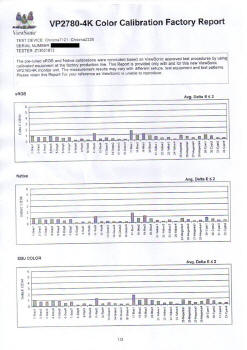
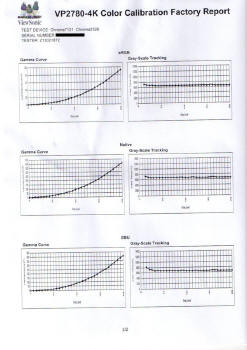
Default settings of the screen were as follows:
|
Monitor OSD Option |
Default Settings |
|
Brightness |
100 |
|
Contrast |
70 |
|
Colour Adjust mode |
Native |
|
RGB |
n/a |
|
Gamma |
2.2 |

ViewSonic VP2780-4K - Default Settings, Native Mode



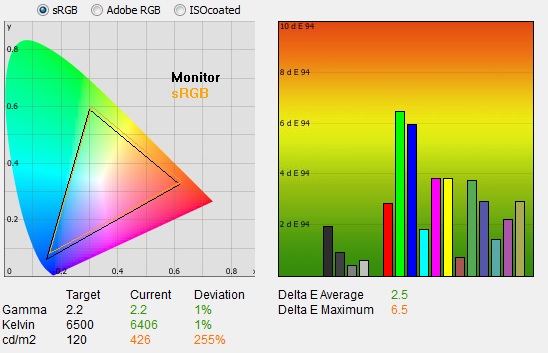
|
|
Default Settings,
Native Mode |
|
luminance (cd/m2) |
426 |
|
Black Point (cd/m2) |
0.39 |
|
Contrast Ratio |
1082:1 |
Initially out of the box the screen was set in the
default 'native' colour adjust mode. At this setting you do not have access to the
RGB levels. Brightness was set at an eye-scorching 100% by default. The screen looked very bright out
of the box, colours felt pretty well balanced and the colour temperature also
felt good.
The
CIE diagram on the left of the image confirms that the monitors colour gamut
(black triangle) is roughly equal to
the sRGB colour space. There is some minor over-coverage in blue shades,
and some minor under-coverage in greens and reds, but not by anything significant.
Default gamma was recorded at 2.2 average, leaving it with only a 1% deviance
from the target which was very good news. White point was measured at 6406k
being very close to the target of 6500k with a minor 1% deviance.

Luminance was recorded at an extremely bright 426
cd/m2 which is
far
too high for prolonged general use. Thankfully you can change the brightness
setting to whatever you like without impacting other areas of the setup. The black depth
at this high brightness level was 0.39 cd/m2, giving us a very good static contrast ratio
(for an IPS-type panel) of 1082:1.
Colour accuracy was mostly pretty good out of the
box, with average dE at 2.5. Blue and green shades were a problem where dE
ranged up to 6.5 maximum. When testing the screen with colour gradients there was some
slight gradation evident as you will see from most monitors in darker tones, but
no banding evident.

We also measured the screen out of the box in the
sRGB (factory calibrated) mode:
|
Monitor OSD Option |
Default Settings |
|
Brightness |
25 |
|
Contrast |
70 |
|
Colour Adjust mode |
sRGB |
|
RGB |
n/a |
|
Gamma |
n/a |

ViewSonic VP2780-4K - Default Settings, sRGB Mode
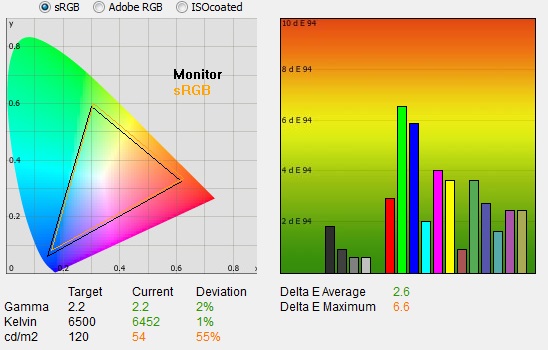
|
|
Default Settings,
sRGB Mode |
|
luminance (cd/m2) |
54 |
|
Black Point (cd/m2) |
0.09 |
|
Contrast Ratio |
574:1 |
When you switch to the sRGB preset mode the
luminance of the screen drops very noticeably. You can see from the OSD menu
that the brightness has been reduced to 25, although you can still change it if
you want to. The default setup remains largely similar to the native mode, with
gamma and white point being only a minor 1 - 2% out from the targets, and dE
being basically the same as before. The main change here was the luminance, now
measured at only 54
cd/m2. This was
lower than we had reached during our initial
brightness range measurements in the native preset mode, even though the
brightness control in the OSD was still at 25 here (and not 0). The contrast
ratio had been reduced as well, now measured at only 574:1. In this preset mode
there seems to be an additional digital white level adjustment applied to bring
the luminance down much lower. However, this crushes contrast ratio which we
don't really want. As a result, we don't feel this mode should be used. Stick to
the native mode, or
calibrate
the user mode if you want and keep a much better contrast ratio.

Calibration
We used the
X-rite i1 Pro spectrophotometer combined with the LaCie Blue Eye Pro
software package to achieve these results and reports. An X-rite i1 Display Pro
colorimeter was used to validate the black depth and contrast
ratios due to lower end limitations of the i1 Pro device.
|
Monitor OSD Option |
Calibrated Settings |
|
Brightness |
8 |
|
Contrast |
70 |
|
Colour Adjust mode |
User Color |
|
RGB |
92, 92, 100 |

ViewSonic VP2780-4K - Calibrated Settings

|
|
Calibrated Settings |
|
luminance (cd/m2) |
122 |
|
Black Point (cd/m2) |
0.12 |
|
Contrast Ratio |
1002:1 |
We changed to the 'user define' colour temperature
mode which gave us access to the RGB channels, allowing us to adjust the white
point at the hardware level. These OSD
changes allowed us to obtain an
optimum hardware starting point and setup before software level changes would be
made at the graphics card level. We left the LaCie software to calibrate
to "max" brightness which would just retain the luminance of whatever brightness
we'd set the screen to, and would not in any way try and alter the luminance at
the graphics card level, which can reduce contrast ratio. These adjustments
before profiling the screen would help preserve tonal values and limit
banding issues. After this we let the software carry out the LUT adjustments and create an
ICC profile.

Average gamma was now corrected to 2.2 average,
correcting the very minor 1% deviance we'd seen out of the box. The white point was now also corrected to 6513k,
again correcting the minor 1% deviance from before. Luminance had been corrected
nicely to 122
cd/m2 and this
left us a black depth of 0.12 cd/m2 and maintained a very good static contrast ratio
(for an IPS-type panel) of
1002:1. Colour accuracy of the resulting
profile was excellent, with dE average of 0.3 and maximum of 0.6. LaCie would
consider colour fidelity to be excellent overall.
Testing the screen with various colour gradients
showed mostly smooth transitions. There was some slight gradation in darker
tones but no banding introduced due to the adjustments to the graphics
card LUT from the profilation of the screen.
You can use our settings and
try our calibrated ICC profile if you wish, which are available in
our ICC profile database. Keep in mind that results will vary from one
screen to another and from one computer / graphics card to another.

Calibration Performance Comparisons

The comparisons made in this section try to give
you a better view of how each screen performs, particularly out of the box which
is what is going to matter to most consumers. When comparing the default factory
settings for each monitor it is important to take into account several
measurement areas - gamma, white point and colour accuracy. There's no point
having a low dE colour accuracy figure if the gamma curve is way off for
instance. A good factory calibration requires all 3 to be well set up. We have
deliberately not included luminance in this comparison since this is normally
far too high by default on every screen. However, that is very easily controlled
through the brightness setting (on most screens) and should not impact the other
areas being measured anyway. It is easy enough to obtain a suitable luminance
for your working conditions and individual preferences, but a reliable factory
setup in gamma, white point and colour accuracy is important and not as easy to
change accurately without a calibration tool.
From these comparisons we can also compare the
calibrated colour accuracy, black depth and contrast ratio. After a calibration
the gamma, white point and luminance should all be at their desired targets.

Default setup of the screen out of the box was
good thanks to the factory calibration, with gamma and white point being only a
very minor 1% away from their targets. The contrast ratio was also strong at
1082:1 for an IPS panel. It was far too bright though but thankfully that's easy
enough to lower with a simple change to the brightness control. We would have
liked a slightly better dE if we're honest, but it still provided good levels of
colour accuracy which should be more than adequate for most normal users.


The display was strong when it came to black depth
and contrast ratio for an IPS-type panel. With a calibrated contrast ratio of
1002:1 it was comparable to some of the better screens using this kind of panel
technology. Anything over 1000:1 would be very good for an IPS panel really at
the moment. It was not quite as high as some models like the
Dell U2515H
(1138:1) which holds the record for an IPS contrast ratio. Of course it can't
compete with VA panel types which can reach over 2000:1 easily, and commonly up
to 3000:1, even close to 5000:1 in some cases like the
Philips BDM4065UC.

Viewing Angles

Above: Viewing
angles shown from front and side, and from above and below. Click for
larger image
Viewing angles of the screen were very good as you
would expect from an IPS-type panel. Horizontally there was very little colour
tone shift until wide angles past about 45°. A slight darkening of the image
occurred horizontally from wider angles as you can see above as the contrast
shifted slighting. Contrast shifts were more noticeable in the vertical field
with the image appearing more pale. A slight pink hue was also introduced
vertically. The screen offered the wide viewing angles of IPS technology and was
free from the restrictive fields of view of TN Film panels, especially in the
vertical plane. It was also free of the off-centre contrast shift you see from
VA panels and a lot of the quite obvious gamma and colour tone shift you see
from some of the modern VA panel types. All as expected really from a modern IPS-type
panel.
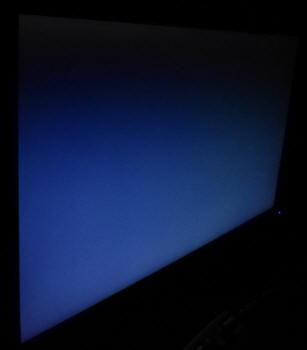
Above: View of an
all black screen from the side. Click for larger version
On a black image there is a pale white / blue
glow when viewed from an angle, commonly referred to as IPS-glow. This kind of
glow is common
on most IPS-type panels and can be distracting to some users. A lot of panels
show a more obvious silvery white glow than this (e.g. see the
recent Asus MG279Q using an IPS-type panel) and so on the VP2780-4K it is
not quite as obvious day to day. It is still there though so something
to be aware of if you work with a lot of dark content. If you view dark content
from a normal head-on viewing position, you can actually see this glow as your
eyes look towards the edges of the screen if the screen is of a large size.

Panel Uniformity
We wanted to test
here how uniform the brightness was across the screen, as well as identify any
leakage from the backlight in dark lighting conditions. Measurements of the
luminance were taken at 35 points across the panel on a pure white background.
The measurements for luminance were taken using BasICColor's calibration
software package, combined with an X-rite i1 Display Pro colorimeter with a
central point on the screen calibrated to 120 cd/m2. The below
uniformity diagram shows the difference, as a percentage, between the
measurement recorded at each point on the screen, as compared with the central
reference point.
It is worth
noting that panel uniformity can vary from one screen to another, and can depend
on manufacturing lines, screen transport and other local factors. This is only a
guide of the uniformity of the sample screen we have for review.

Uniformity of Luminance

The luminance uniformity of the screen was
reasonable overall with the four corners
showing some drop in luminance by about -20% in the most extreme cases. The
upper and central regions were closer to the calibrated central point of the
screen. Around 51% of the screen was within a 10% deviance of the centrally
calibrated point.

Backlight Leakage
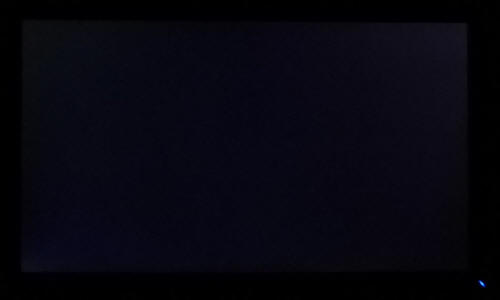
Above: All black screen in a darkened room. Click for larger version
As usual we also tested the screen with an all
black image and in a darkened room. A camera was used to capture the result. The
camera showed there was some clouding in the upper right hand corner but nothing
very noticeable at all, and certainly not something you'd see during normal
uses.

General and Office Application

The VP2780-4K feature a massive 3840 x 2160 Ultra
HD
resolution, all packed in to a 27" sized screen. As we touched on in our
introduction section, the higher resolution is not about providing more screen
real-estate here and we need to move away from thinking about LCD resolution in
that manner. In fact it is arguable that the wide range of 2560 x 1440
resolution panels in the 27" sector are about as high a resolution as you want
to go, without making fonts and icons too small natively. That provides a pretty
comfortable option to work with day to day.
Here, with the resolution being so much higher it
is about providing a sharper and crisper image, while still operating with a
similar desktop area and similar font size to the 1440p models. It is providing
a higher pixel density (Pixels Per Inch, PPI) to improve the degree of
definition to the image. You need to us operating system scaling to handle this
properly. If you try and run the screen without any scaling at 3840 x 2160 the
0.156mm pixel pitch makes everything far too small and tiny. In our view you
need a screen of about 39 - 40" in size (like the
Philips BDM4065UC) to use an Ultra HD or 4K resolution effectively without
OS scaling. On this ViewSonic 27" model, if you increase the scaling to 150%,
you actually end up with the same workspace area as 2560 x 1440, but at a much
higher PPI pixel density - and therefore a sharper image. Have a read of
Eizo's very useful article for some more information on the whole matter. For
those wanting a high pixel density for CAD, design, photo work etc, this is a
really good option. The image was very sharp and crisp and text was very clear.
Keep in mind that not all Operating Systems and
applications handle scaling the same. More recent versions of Windows (8.1 and
10) tend to handle it all better, and recent versions of Mac OS are pretty solid
as well. Some applications and games don't handle scaling correctly and so you
can end up with some things with very minute text and fonts and some things
which don't scale completely in every place. Keep this in mind if you're
selecting any super high resolution display as it could be an important factor.
You need to ensure you have the necessary operating system and applications to
handle scaling effectively for your needs.
You do need to keep in mind the need for a
compatible graphics card with a suitable output which can handle this
resolution, and preferably at 60Hz refresh rate. DisplayPort and HDMI 2.0 are
the only options to run the screen at its native 3840 x 2160 res at 60Hz, so are
certainly recommended. When running at native resolution this model is
recognised as a single display which makes life easier than some of the early MultiStream (MST) models. It's also good to see support for 60Hz refresh rate as
some 4k models only offer 30Hz support which is very limiting, even in day to
day uses (certainly for gaming!).
The light AG coating of the
panel is
welcome, and much better than the grainy and 'dirty' appearance
of older IPS AG coatings.
The wide
viewing angles provided by this panel technology on both horizontal and
vertical planes, helps minimize on-screen colour shift when viewed from
different angles.
The default setup of the screen was strong thanks
to the factory calibration, offering an accurate gamma curve and white point
along with a decent contrast ratio and fairly low dE. The brightness range of the
screen was also very good, with the ability to offer a luminance between 411 and
93 cd/m2. This should mean the screen is perfectly useable in a wide
variety of ambient light conditions, including darkened rooms. We would have
perhaps liked a little more control at the lower end, and a lower maximum
luminance as >400 is unnecessary. A setting of ~8 in the OSD brightness control
should return you a luminance close to 120 cd/m2 out of the box. On
another positive note, the brightness regulation is controlled without the need
for the use of the now infamous
Pulse-Width Modulation (PWM), and so those who suffer from eye fatigue or
headaches associated with flickering backlights need not worry. There was no
audible noise or buzzing from the screen, even when specifically looking for it
using test images with a large amount of text at once. The screen also remains
cool even during prolonged use.
The screen offers 4x USB 3.0 ports (with charging
capabilities also) which is very handy. There aren't any other extras like card readers or ambient light sensors offered
though. The stand offers a wide range of adjustments which is great news,
allowing you to obtain comfortable viewing positions easily.

Above: photo of
text at 3840 x 2160 (top) and 2560 x 1440 (bottom)
The screen is designed to run at its native
resolution of 3840 x 2160 and at a 60Hz recommended refresh rate. However,
if you want you are able to run the screen outside of this resolution. We tested
the screen at a lower 2560 x 1440 resolution to see how the screen handles the
interpolation of the resolution, while maintaining the same aspect ratio of
16:9. At native resolution the text was very sharp and clear although you need
scaling to ensure the image is useable without being tiny. When running at a
1440p resolution the text is still reasonably clear, with low levels of
blurring. You do lose a lot of sharpness and image clarity though if you run at
a lower resolution and let the screen scale it for you. You're better off
running the screen at full resolution and letting your operating system and
applications scale it back down to a comfortable viewing size.

Responsiveness and Gaming
|
Quoted G2G Response Time |
5ms G2G |
|
Quoted ISO Response Time |
n/a |
|
Panel Manufacturer and
Technology |
LG.Display AH-IPS |
|
Panel Part |
LM270WR2 |
|
Overdrive Used |
Yes |
|
Overdrive Control Available to
User |
Response Time |
|
Overdrive Settings |
Standard, Advanced, Ultra Fast |
The VP2780-4K is rated by ViewSonic as having a 5ms G2G response time, which indicates the panel uses
overdrive /
response time compensation (RTC) technology to boost pixel transitions
across grey to grey changes. There is a user control over the overdrive impulse
within the OSD menu using the 'Response Time' option also. The
part
being used is the
LG.Display LM270WR2 AH-IPS panel. Have a read about response time in
our
specs section if you need additional information about response times and
their measurement.
We will first test the screen using our thorough
response time testing method. This uses an oscilloscope and photosensor to
measure the pixel response times across a series of different transitions, in
the full range from 0 (black) to 255 (white). This will give us a realistic view
of how the monitor performs in real life, as opposed to being reliant only on a
manufacturers spec. We can work out the response times for changing between many
different shades, calculate the maximum, minimum and average grey
to grey (G2G) response times, and provide an evaluation of any overshoot present
on the monitor.
We use an
ETC M526
oscilloscope for these measurements along with a custom photosensor device.
Have a read of
our response time measurement article for a full explanation of the testing
methodology and reported data.
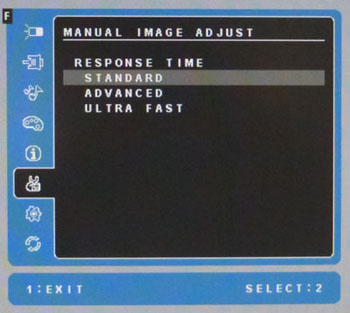
The VP2780-4K comes with a user control for the
overdrive impulse available within the OSD menu in the 'manual image adjust'
section as shown above. There are 3 options available here under the 'Response
Time' setting. First of all we carried out a smaller sample set of measurements
in all 3 of the settings. These, along with various motion tests allowed us to
quickly identify which was the optimum overdrive setting for this screen.

With response time set to 'standard', the overall
responsiveness was pretty slow. An average 13.4ms G2G was measured, with some
rise times being particularly slow, up to 23.8ms here in the transitions
measured. Since overdrive was turned down very low, maybe even off completely,
there was no overshoot detected at all. However, moving images showed obvious
blurring which we hope the other response time settings will help reduce.

The 'advanced' mode provided some obvious
improvements. Response times had now sped up to 9.3ms G2G average, with the very
slow transitions from before being boosted nicely. There was very little in the
way of overshoot, although a few transitions started to show low levels in our
measurements. Nothing you could really notice in practice though. This mode is
definitely preferable compared with the 'standard' setting.

Switching up to the maximum 'Ultra Fast' mode
improved response times again, now down to 7.8ms G2G average. However, it was at
the cost of high and very noticeable levels of overshoot. This mode should be
avoided really. Stick with 'advanced' mode.
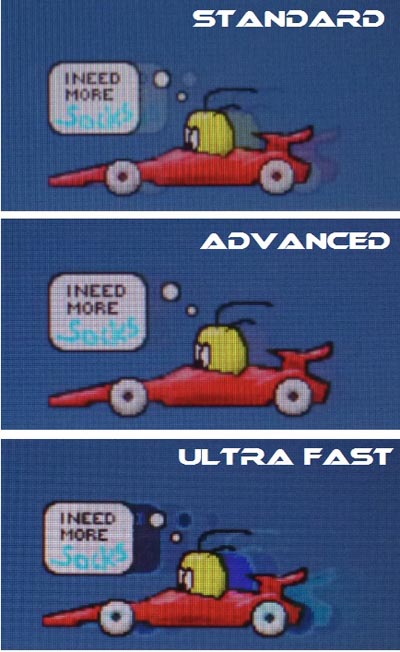
If we take some test photos using the PixPerAn
tool you can make some further visual comparisons between the overdrive
settings. With response time set in the 'standard' mode there is a noticeable
blurring to the moving image as response times are slow. When you move the
setting up to 'advanced' the blurring is reduced nicely, and the moving image
becomes clearer and sharper. No overshoot is apparent at this setting still. If
you move to the 'ultra fast' mode there is a significant and very noticeable
level of overshoot introduced, in the form of dark and pale trails. The advanced
mode is certainly the optimum on this screen.

More Detailed Measurements
Response Time = Advanced
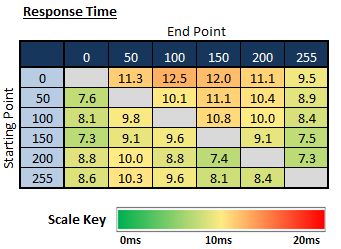
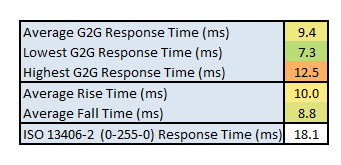
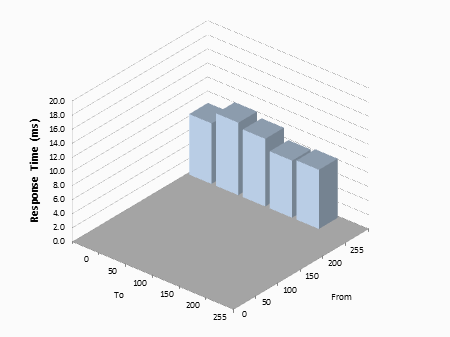
The average G2G response time was measured at
9.4ms which was fairly good for an IPS-type panel. Transitions to white (x >
255) and to black (x > 0) were the fastest, with some reaching down to as low
as 7.3ms. None reached as low as the specified 5ms figure. Maybe that's
achievable on some transitions with Response Time pushed up to Ultra Fast, but
we know that it only introduces massive amounts of overshoot anyway. Intermediate changes between grey shades were slower,
reaching up to 12.5ms in the worst case. To give you an idea, a fast 60Hz IPS-type panel can reach down to around
8.6ms G2G average without introducing lots of overshoot, so the VP2780-4K fell slightly
behind here, but not by a massive amount really. It's not aimed at gamers so
actually it's a pretty decent performance.
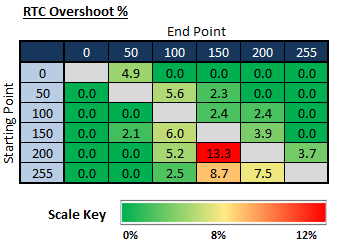
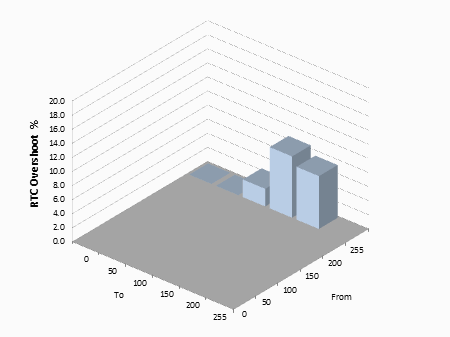
There was very little overshoot at this Response
Time setting, with only a couple of transitions showing anything noticeable.
Overall we were pleased with this setup as we wouldn't have wanted to sacrifice
more overshoot really for the sake of a few tenths of a millisecond speed
improvement.

Display Comparisons
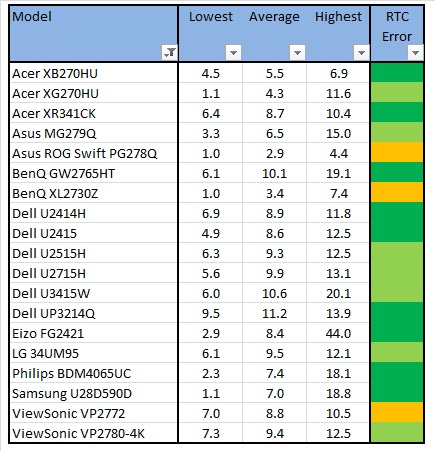
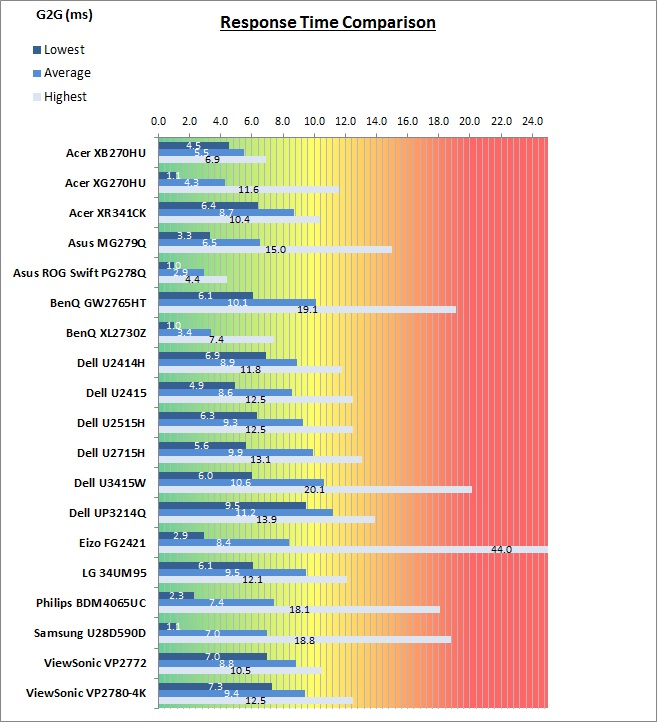
The above comparison table and graph shows you the
lowest, average and highest G2G response time measurement for each screen we
have tested with our oscilloscope system. There is also a colour coded mark next
to each screen in the table to indicate the RTC overshoot error, as the response
time figure alone doesn't tell the whole story.
The measured response times of the VP2780-4K were
reasonable for an IPS-type panel, measured at 9.4ms G2G average with very little
overshoot. The fastest 60Hz IPS panels can reach down to around 8.6ms G2G
without overshoot so that should give you an idea of where the ViewSonic lies.
The previous
ViewSonic VP2772 model (wide gamut, 1440p resolution) was a little bit
faster at 8.8ms G2G response time but had moderate levels of overshoot, higher
than on the new VP2780-4K. The new 144Hz capable IPS-type panels in the
Asus MG279Q and
Acer
XB270HU are faster, reaching down to 5.5 - 6.5ms with little to no overshoot. Modern TN Film panels are faster than the
VP2780-4K as well as you might
expect, reaching down to 2.9 - 3.4ms G2G average on models like the
Asus ROG
Swift PG278Q and
BenQ XL2730Z respectively, but
only at the cost of moderate levels of
overshoot being introduced.
The screen was also tested using the chase test in
PixPerAn for the following display comparisons. As a reminder, a series of
pictures are taken on the highest shutter speed and compared, with the best case
example shown on the left, and worst case example on the right. This should only
be used as a rough guide to comparative responsiveness but is handy for a
comparison between different screens and technologies as well as a means to
compare those screens we tested before the introduction of our oscilloscope
method.

27"
5ms
G2G LG.Display AH-IPS (Response Time = Advanced)
In practice the VP2780-4K showed low levels of
blurring in these tests, with the moving object looking sharp and clear. There
was no overshoot detected in these specific tests at this setting, but we know
there are some low levels of overshoot on some transitions form our oscilloscope
tests.

27"
5ms
G2G LG.Display AH-IPS (Response Time = Advanced)

27"
6ms
G2G LG.Display AH-IPS (Response Time = Advanced)

27" 12ms G2G
Samsung PLS (Response Time = Advanced)

27"
8ms
G2G LG.Display AH-IPS (Response Time = Normal)
It is also interesting to compare the VP2780-4K with the previous ViewSonic 27"
VP models. The old VP2772 (wide gamut, 1440p resolution) showed pretty similar
levels of blurring in practice, but did have a more obvious overshoot issue than
the new screen. Before that, the VP2770-LED (standard gamut, 1440p) was perhaps
slightly slower but was free from overshoot problems at least. The popular
Dell U2715H (1440p) was very similar to the VP2780-4K overall really,
perhaps ever so slightly slower.

27"
5ms
G2G LG.Display AH-IPS (Response Time = Advanced)

27"
4ms G2G AU Optronics AHVA (IPS-type)
@ 144Hz (OD = Normal)

27"
1ms
G2G AU Optronics TN Film @ 144Hz (OD = Normal)

27"
1ms
G2G AU Optronics TN Film @ 144Hz (AMA = High)

23.5" 4ms G2G
Sharp MVA + 120Hz
We've also included a comparison above against
some other very fast 120Hz+ compatible screens we have tested. The screens shown
here are all aimed primarily at gamers and have various features and extras
which make them more suitable overall for gaming.
Firstly there is a comparison against the excellent
Acer XB270HU with very fast response times (5.5ms G2G, no overshoot), 144Hz
refresh rate and also NVIDIA G-sync and Ultra Low Motion Blur (ULMB) support.
It's currently our bench-mark for IPS panel gaming - well, actually our
current favourite gaming screen of any type!
Then there's the very popular
Asus ROG Swift PG278Q with its 144Hz refresh rate and fast response time TN
Film panel. This showed very fast pixel response times (2.9ms G2G), with
moderate levels of overshoot, but smooth movement thanks to its increased
refresh rate. You are able to reduce the motion blur even more through the use
of the ULMB strobed backlight as well if you need to and again this model also
supports NVIDIA's G-sync technology.
Then there is a comparison against the
BenQ XL2730Z
with another very fast TN Film panel and 144Hz refresh rate. This showed very
low levels of motion blur (3.4ms G2G), but some dark overshoot was introduced as a
side-effect as you can see. This screen also includes a native Blur Reduction
mode to help eliminate further perceived motion blur and works well, along with
AMD FreeSync support.
Lastly there is the MVA based
Eizo Foris FG2421 screen
with a fast response time (especially for the panel technology being used) and
120Hz refresh rate support. There is also an additional 'Turbo 240' motion blur
reduction mode which really helps reduce the perceived motion blur in practice.

On another note the Ultra HD resolution is also
very impressive for games, providing a very sharp image and a lot of detail.
Images look sharp and crisp even up close. One
big consideration you need to make is that the 3840 x 2160 @ 60Hz resolution is
likely to be a major drag on even high end graphics cards and PC systems when it
comes to gaming. You really need to think about the type of game you want to
play, the settings you want to use, and whether your system can handle
outputting such a high resolution effectively. Your graphics card will also need
to support DisplayPort 1.2 or HDMI 2.0. Other interfaces including the HDMI 1.4
inputs are limited to 30Hz at 3840 x 2160. Don't forget that many gaming titles
don't support this 4k resolution either, so that could be another issue. Some
games don't handle scaling very well and so when it comes to the user interface
a lack of scaling results in tiny text or hard to read maps etc. Be wary of that
as well as the game needs to handle scaling properly on a screen this size.
One option of course is to run the game at a lower
resolution and let the screen scale it. That's probably the most sensible option
in most cases and we know that the interpolation of lower resolutions like 2560
x 1440 and 1920 x 1080 is pretty good on this model. It does kind of defeat the
point of having a 4k resolution in the first place though. If you have games
which can natively support this resolution properly, they would look fantastic
given the very high resolution and high pixel density. External games consoles
running at 1080p will still look ok, and the image is interpolated quite well.

Additional Gaming Features
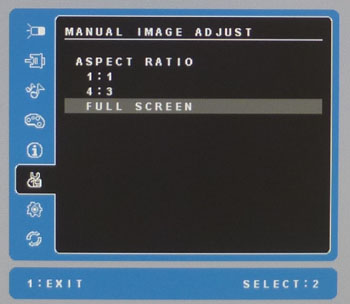
-
Aspect Ratio Control -
The VP2780-4K has three options in the menu for
aspect ratio control. There are options for 1:1 pixel mapping, full screen
and 4:3 only. There is no "aspect" option to maintain the source aspect at
whatever it is, but fill the screen as much as possible. This isn't a major
problem on this screen as if you're using a PC and want to run at a non-native
resolution (for gaming etc) you can let the graphics card handle the scaling
instead. Since the screen is a native 16:9 aspect ratio as well, if you are
using an external device (games console, Blu-ray player) it should be ok since
those generally run at 16:9 aspect themselves. External inputs not from a PC of
16:10, 5:4 aspect ratios will be an issue though unless you run them at 1:1
pixel mapping, which will be a very small window given the resolution of the
panel.
-
Preset Modes -
There are a specific game preset modes available
on this screen in the 'Viewmode' option of the 'manual image adjust' section of
the OSD. This seems to have a slightly different gamma curve than the default
~2.2, and it also results in a locked brightness/contrast section. It might be
easier to just change your standard mode to suit your gaming.

Lag
We have written an in depth article about
input lag and the various measurement techniques which are used to evaluate
this aspect of a display. It's important to first of all understand the
different methods available and also what this lag means to you as an end-user.
Input Lag vs. Display Lag vs. Signal
Processing
To avoid confusion with different terminology we
will refer to this section of our reviews as just "lag" from now on, as there
are a few different aspects to consider, and different interpretations of the
term "input lag". We will consider the following points here as much as
possible. The overall "display lag" is the first, that being the delay between
the image being shown on the TFT display and that being shown on a CRT. This is
what many people will know as input lag and originally was the measure made to
explain why the image is a little behind when using a CRT. The older stopwatch
based methods were the common way to measure this in the past, but through
advanced studies have been shown to be quite inaccurate. As a result, more
advanced tools like SMTT provide a method to measure that delay between a TFT
and CRT while removing the inaccuracies of older stopwatch methods.
In reality that lag / delay is caused by a
combination of two things - the signal processing delay caused by the TFT
electronics / scaler, and the response time of the pixels themselves. Most
"input lag" measurements over the years have always been based on the overall
display lag (signal processing + response time) and indeed the SMTT tool is
based on this visual difference between a CRT and TFT and so measures the
overall display lag. In practice the signal processing is the element which
gives the feel of lag to the user, and the response time of course can
impact blurring, and overall image quality in moving scenes. As people become
more aware of lag as a possible issue, we are of course keen to try and
understand the split between the two as much as possible to give a complete
picture.
The signal processing element within that is quite
hard to identify without extremely high end equipment and very complicated
methods. In fact the studies by Thomas Thiemann which really kicked this whole
thing off were based on equipment worth >100,1000 Euro, requiring extremely high
bandwidths and very complicated methods to trigger the correct behaviour and
accurately measure the signal processing on its own. Other techniques which are
being used since are not conducted by Thomas (he is a freelance writer) or based
on this equipment or technique, and may also be subject to other errors or
inaccuracies based on our conversations with him since. It's very hard as a
result to produce a technique which will measure just the signal processing on
its own unfortunately. Many measurement techniques are also not explained and so
it is important to try and get a picture from various sources if possible to
make an informed judgement about a display overall.
For our tests we will continue to use the SMTT
tool to measure the overall "display lag". From there we can use our
oscilloscope system to measure the response time across a wide range of grey to
grey (G2G) transitions as recorded in our
response time
tests. Since SMTT will not include the full response time within its
measurements, after speaking with Thomas further about the situation we will
subtract half of the average G2G response time from the total display lag. This should allow us to give a good estimation of
how much of the overall lag is attributable to the signal processing element on
its own.
Lag Classification
To help in this section we will also introduce a broader classification system
for these results to help categorise each screen as one of the following levels:
-
Class 1)
Less than 16ms / 1 frame lag at 60Hz - should be fine for gamers, even at high levels
-
Class
2)
A lag of 16 -
32ms / One to two frames of lag at 60Hz - moderate lag but should be fine for many gamers.
Caution advised for serious gaming and FPS
-
Class
3)
A lag of more
than 32ms / more than 2 frames of lag at 60Hz - Some noticeable lag in daily usage, not
suitable for high end gaming

For the full reviews of the models compared here and the dates they were written
(and when screens were approximately released to the market), please see our
full
reviews index.
|
(Measurements in ms) |
|
|
Total Display Lag (SMTT
2) |
15.00 |
|
Pixel Response Time
Element |
4.70 |
|
Estimated Signal
Processing Lag |
10.30 |
|
Lag Classification |
1 |
|

Class
1 |
We have provided a comparison above against other
models we have tested to give an indication between screens. The screens
tested are split into two measurements which are
based on our overall display lag tests (using SMTT) and half the average G2G
response time, as measured by the oscilloscope. The response time is split from
the overall display lag and shown on the graph as the green bar. From there, the
signal processing (red bar) can be provided as a good estimation.
The VP2780-4K showed a total display lag of 15.0ms.
4.70ms of this can be accounted for by pixel response times roughly, leaving us
with approximately 10.3ms of signal processing lag. This is less than 1 frame at 60Hz refresh rate
and is a good result and low level of lag. It should be fine for most gamers,
although some people wanting to play FPS or competitive games might need
something even lower.

Movies and Video

The following summarises the screens performance
in video applications:
-
27"
screen size makes it a reasonable option for an all-in-one multimedia screen,
much smaller than LCD TV's and many larger format desktop monitors which are
now emerging.
-
16:9
aspect ratio is well suited to videos and movies, leaving
you with smaller/no borders on DVD's and wide screen content at the top and
bottom than on a 16:10 aspect display.
-
3840 x
2160 resolution can support full 1080 HD resolution content and also Ultra HD
"4k" content natively.
-
Digital interfaces support HDCP for any encrypted and protected content
-
Good range of interface options available
here with DisplayPort, Mini DP, HDMI 1.4 (x2), MHL 2.0 (x2) and HDMI 2.0
available.
-
Cable provided in the box
for DisplayPort, MHL and HDMI.
-
Light
AG coating provides clear images with no major graininess, and without the
unwanted reflections of a glossy solution.
-
Wide
brightness range adjustment possible from the display, including high maximum
luminance of ~411
cd/m2 and a good minimum luminance of
93 cd/m2. This should afford you very good control for different
lighting conditions. Contrast ratio remains stable across most of that
adjustment range as well and is excellent for an IPS-type panel at >1000:1.
Brightness regulation is controlled without the need for PWM and so is flicker
free at all settings which is pleasing.
-
Black
depth and contrast ratio are very good for an IPS-type panel at 1002:1
after calibration. Detail in darker scenes should not be lost as a result.
-
Good
pixel responsiveness which can handle fast moving scenes in movies without
issue. No noticeable overshoot issues as long as you stick to the 'advanced'
response time setting.
-
Wide viewing angles from IPS panel technology
meaning several people could view the screen at once comfortable and from a
whole host of different angles. Pale glow from an angle on black content may
be problematic to some users and is common for IPS panel technology.
-
No
real backlight leakage on our sample but results may vary.
-
Very good range of ergonomic adjustments
available from the stand, with tilt, height, swivel and rotate offered. Should
be easy enough to get a comfortable setup for movie viewing from different
viewing positions.
-
No integrated speakers provided on this model, but there is a headphone
connection for audio pass through over HDMI.
-
Hardware aspect ratio control provided with options for full, 1:1 pixel
mapping and 4:3.
Missing an "auto aspect" which may be problematic for
some external devices depending on their source aspect ratio.
-
Picture By Picture (PbP) or Picture In Picture (PiP) are available on this
model if you want to use them.

Conclusion
The VP2780-4K offered a very good all-round
screen with a robust and sturdy design and feature set. The versatile stand,
wide range of connectivity options and useful extras like USB 3.0 ports and
PiP/PbP were pleasing, and showed that ViewSonic continue to offer high end
features from their VP series. The design of the screen is fairly industrial and
perhaps lacks the wow factor of some alternative designs in the market. Maybe
the stand needs a bit of a refresh in the future? However, it is solid and
reliable and will no doubt suit a lot of people's taste all the same.
This is the first of their VP range to offer
Ultra HD 3840 x 2160 resolution, and it does this well - offering 60Hz refresh
rate support over both DisplayPort and HDMI 2.0. As ever with super high
resolutions like this you need to keep in mind the support for effective scaling
from your operating system and applications. You also need to consider the
demands on your graphics card when it comes to multimedia uses at such a high
resolution. The high pixel density on a 27" screen size provided a sharp and
clear image which is the main aim of course.
In other performance areas the factory
calibration provided a decent default setup with reliable gamma, white point and
a strong contrast ratio. You don't have the option of wide gamut support on this
model like the previous VP2772, so keep that in mind if you wanted to work with
wide gamut content. The flicker free backlight and light AG coating were welcome
as ever and although the response time was slightly slower than other 60Hz IPS
panels it was still pretty decent, and at least free from noticeable overshoot.
The display lag was also pretty low and so the screen could be a reasonable
option for Ultra HD gaming on an IPS panel at the moment. There were only really
a couple of minor performance negatives we felt. We would have gladly sacrificed
a bit off the top end of the very high brightness adjustment range for the sake
of a bit more control at the lower end in an ideal World. Also there wasn't an
aspect ratio option to maintain the source aspect but fill more of the screen.
You have 1:1 at least, but we would have liked this additional option. Overall
though we are picking a bit and the screen impressed us with very good all-round
performance and a wide selection of extras.
If you appreciate the review
and enjoy reading and like our work, we would welcome a
donation
to the site to help us continue to make quality and detailed reviews for you.
|
Pros |
Cons |
|
Good connectivity options and
stand ergonomics provided |
Industrial design maybe not to
everyone's taste. Stand is quite deep |
|
High pixel density provides
very sharp image |
Minimum brightness range could
have been slightly better |
|
Good factory calibration and
default setup |
Missing an aspect ratio
control option to maintain source aspect, but fill more of the screen. |